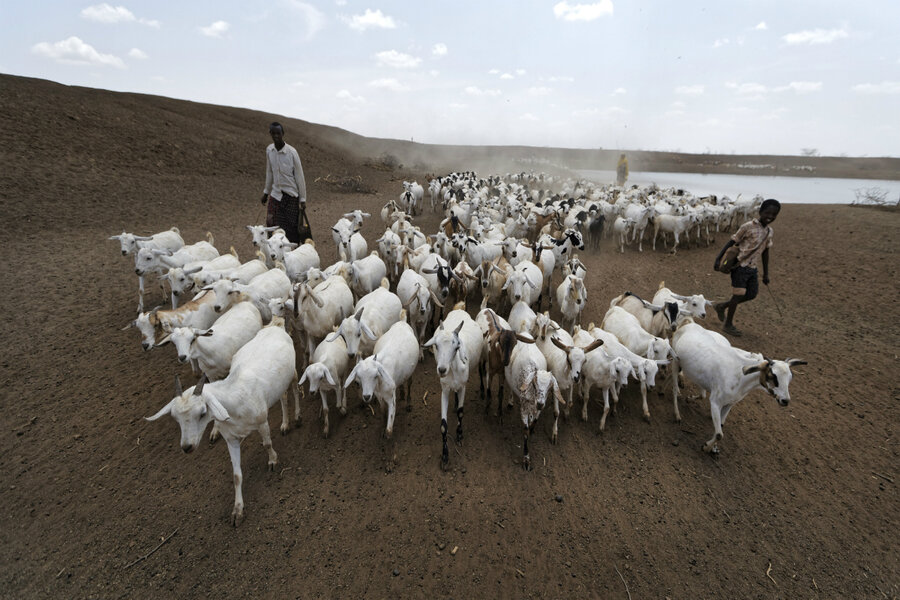New app helps Kenyan herders cut drought risks
Loading...
| Arkamana, Kenya
During times of drought, herder Buchu Boru has to walk many miles in search of pasture for his animals – with no guarantee he will find it.
"Somebody tells you by word of mouth that there is pasture but on arriving you don’t [find] any,” said the herder, who has had to walk from his home all the way across the Ethiopian border to find grass some years.
But next time the rains fail – an increasingly common problem in northern Kenya – he hopes a new mobile phone app will help him move his livestock to fodder without too much cost or waste of time.
The Afriscout app, which uses satellite images to identify where there is grass and surface water, "is better than what we are used to," he said.
As climate change brings longer droughts and more unpredictable rainfall, herders often need to travel further and to less-well-known areas to find grass and water for their animals.
Technology that reduces the uncertainties associated with the journeys can help protect herds and incomes, making families more resilient to the harsher conditions, experts say.
Wrong advice
Mr. Boru and his neighbors normally rely on word-of-mouth to determine where to go, or they phone others in the region, or pay a scout to travel on a pasture-seeking mission.
But the hunt is time consuming, and sometimes goes wrong.
Boru vividly remembers, during a 2016 drought, traveling five days with his cattle, sheep, and goats to Ambalo, about 50 miles away, where he had heard there was pasture.
But "on arrival at Ambalo, there was no pasture. It was dry. I lost 13 cattle in total, some on the way and others in Ambalo," Boru said.
With the app, "we will not be gambling with our livestock," he said. "We will be very sure where the pasture and water is and we will just head there."
Afriscout, developed by Project Concern International (PCI), a California-based development organization, launched in Boru's area in February.
As well as providing detailed grazing maps showing water and grass conditions, herders can contribute information about livestock diseases, predators, and conflicts.
The app so far has about 3,000 users in Kenya, though PCI hopes to increase that to 4,000 once it finishes mapping Samburu County, home to the Samburu herding community.
The app is already used in Tanzania and Ethiopia and PCI plans to deploy it in Niger soon, said Brenda Wandera, the organization's acting representative in Kenya.
About 12 miles north of Boru's village of Arkamana lies Kukub, where Liban Waqo lives with his 40 cattle, 30 goats, and a dozen camels. The herder complains that drought is becoming more frequent and severe in his area.
“We have tried digging boreholes, some even 290 meters deep, but we were not successful. Fifteen boreholes have been dug but we found water in only one,” he said.
Now he has installed the PCI app on his phone and hopes that it will come in handy when the next dry season starts.
Few phones
The new app faces a few challenges, including limited mobile phone connectivity in some areas, and broad use of durable old-style mobile phones rather than more fragile smart phones.
So far, few herders in the region own smart phones – but that may change if they find the app useful, said Andrew Mude of the International Livestock Research Institute (ILRI).
“We have seen evidence of pastoralists accessing smartphones when they recognize the value it delivers,” said Mr. Mude who helped pioneer the use of satellite imagery to trigger insurance payouts for herders when forage is scarce.
Mude says the app could be improved by including a broader range of information – including data about the market price of livestock.
The app could be part of a broader push to protect herders from worsening drought, helping them cut livestock deaths even as a government livestock insurance program helps them recover from unavoidable losses, he said.
This year, in Arkama village, spring rains have transformed the drought-scorched land and brought some respite. Once-empty ponds and dams are now full and there is enough grass to keep the villagers’ animals fed for at least another two months.
But herders say they cannot count on such conditions anymore – though they, and their animals, are happy this year.
“Now they do not have to go far for grass and water,” Boru said.
This story was reported by the Thomson Reuters Foundation.





